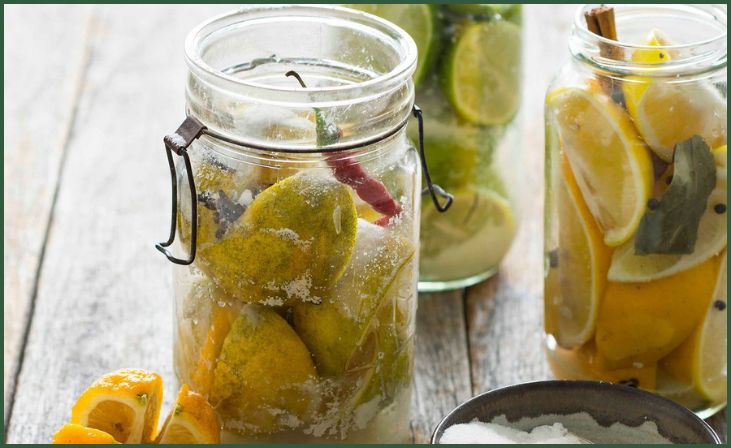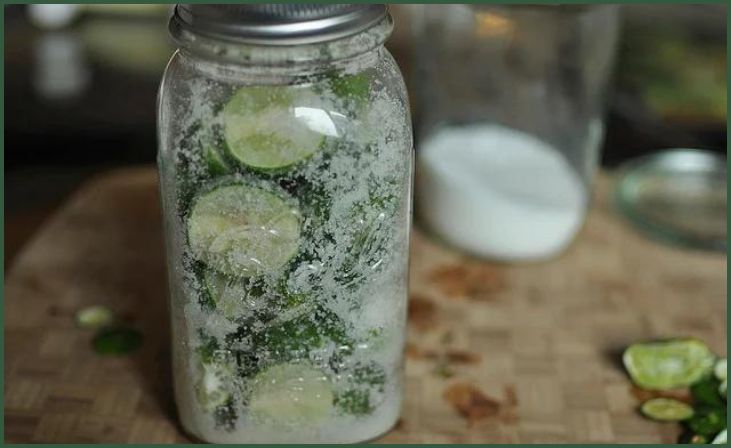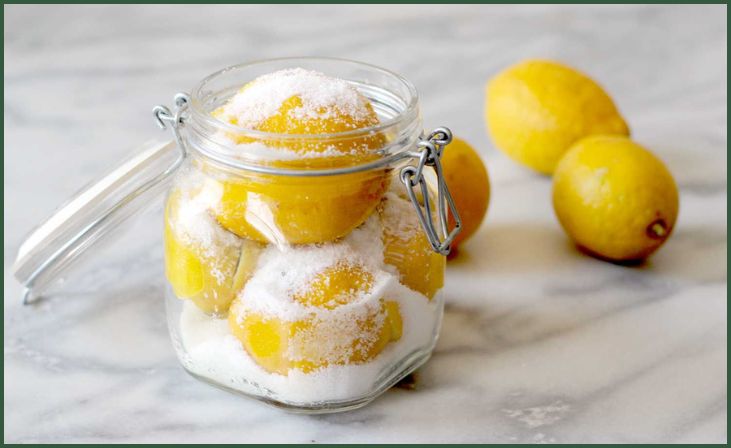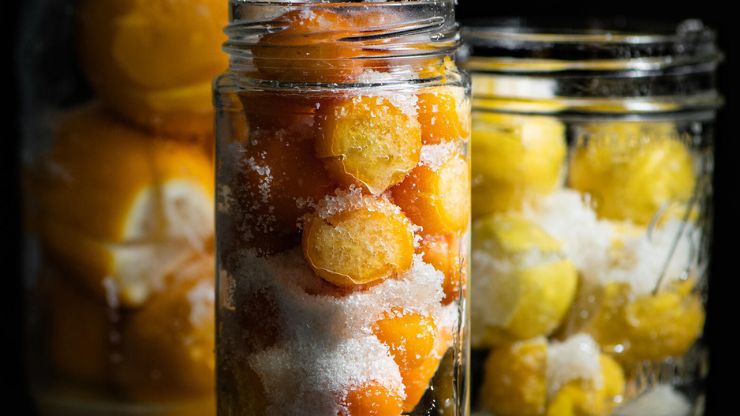Looking to add a zesty twist to your culinary adventures? Delve into the world of preserved limes infused with the goodness of salt. From enriching flavors to extending shelf life, the versatile uses of salt-preserved limes are a culinary treasure trove. This comprehensive guide unveils 15 innovative ways to incorporate this tangy delight into your kitchen repertoire, elevating your dishes to new heights of flavor and zest.
Table of Contents
Toggle15 Ways to Use Salt-Preserved Limes
Flavorful Marinades

Introduce a delightful tang to your marinades by incorporating salt-preserved limes into the mix. As the limes tenderize the meat or seafood, the subtle saltiness and refreshing tang infuse the dish, creating a nuanced flavor profile that tantalizes the taste buds. Whether you’re grilling, roasting, or pan-searing, these marinated delights will leave a lasting impression on your palate.
Tangy Salad Dressings
Combine the brightness of salt-preserved limes with the richness of olive oil, fresh herbs, and a touch of honey to craft invigorating salad dressings. The resulting fusion of tanginess and subtle sweetness transforms even the simplest greens into a refreshing and palate-pleasing feast, perfect for light lunches or as a complement to heartier main courses.
Exotic Rice Pilafs
Elevate your rice pilafs to new heights by infusing them with the captivating tang of salt-preserved limes. As the grains absorb the distinctive citrusy notes, they harmonize with the earthy flavors, creating a vibrant medley that adds an exotic twist to your dinner table, transporting your taste buds to distant lands with every flavorful bite.
Also Read: Stages of Fermentation
Spicy Salsas
Amp up the complexity of your salsas by incorporating finely chopped salt-preserved limes. Their tangy essence serves as a perfect counterbalance to the fiery heat, creating a salsa that tantalizes the palate with a tantalizing dance of flavors. Whether you’re enjoying it with chips, tacos, or grilled meats, this salsa will be the star of your dining experience.
Citrus-Infused Seafood Dishes
Introduce a burst of citrusy freshness to your seafood creations by incorporating salt-preserved limes into your recipes. Whether you’re grilling flaky fish or preparing succulent shrimp scampi, the zesty tang of the limes uplifts the natural flavors of the seafood, creating a culinary experience that is as vibrant as it is satisfying.
Refreshing Beverages
Harness the invigorating essence of salt-preserved limes to concoct a variety of revitalizing beverages. From classic limeades and lemonades to more spirited margaritas, the distinctive tang of the limes balances the sweetness, resulting in drinks that are perfect for quenching your thirst and enlivening your spirits on any occasion, be it a leisurely afternoon or a festive gathering.
Aromatic Infused Oils
Enliven your dishes with the tantalizing aroma and rich flavor of infused oils crafted by steeping salt-preserved limes in quality olive or avocado oil. Drizzle these aromatic oils over salads, use them as dipping sauces for bread, or incorporate them into your roasted vegetable dishes to impart a burst of tangy and savory goodness to every bite.
Tangy BBQ Glazes

Transform your barbecue experience by incorporating the dynamic flavors of salt-preserved limes into your homemade glazes and sauces. Whether you’re grilling tender ribs, succulent chicken, or savory pork, the tangy and savory notes of the limes complement the smokiness of the grilled meats, elevating your barbecue feast to new levels of culinary excellence.
Citrusy Couscous
Infuse your couscous dishes with the invigorating essence of salt-preserved limes by incorporating finely chopped limes into the cooking process. The resulting coupling of the couscous’s mild taste with the zesty and citrusy essence of the limes creates a fragrant and delightful side dish that pairs perfectly with a variety of main courses, offering a satisfying and flavorful culinary experience.
Don't just scroll, subscribe!
BuzzTrail's unique web-stories are the cure for boredom you've been waiting for.
Middle Eastern Stews
Add a burst of excitement to your comforting Middle Eastern stews by incorporating the tangy and salty essence of salt-preserved limes. As the limes infuse the stew with their complex and vibrant flavor profile, they elevate the hearty dish, creating a comforting and satisfying meal that is perfect for cozy evenings and gatherings with friends and family.
Tangy Pasta Sauces
Indulge in the robust and tangy flavors of pasta sauces that come alive with the addition of salt-preserved limes. By blending these tangy gems with fresh herbs, ripe tomatoes, and a touch of cream, you create pasta sauces that are rich, flavorful, and irresistible, with the tanginess of the limes providing a refreshing twist that keeps your taste buds dancing with delight.
Exotic Chutneys
Delight your taste buds with the complex and alluring flavors of exotic chutneys created by simmering salt-preserved limes with an array of spices, a touch of sugar, and a dash of vinegar. The resulting chutneys strike the perfect balance between tanginess, sweetness, and spice, making them the ideal accompaniment for a variety of dishes, from grilled meats to flaky samosas and indulgent cheese platters.
Tangy Vinaigrettes
Whip up tantalizing vinaigrettes that harmoniously blend the vibrant flavors of salt-preserved limes with the zing of vinegar, the robustness of Dijon mustard, and the delicate sweetness of honey. These vinaigrettes offer the perfect balance of acidity and sweetness, making them the ideal dressing for an array of salads, whether they feature leafy greens, hearty grains, or even an assortment of juicy fruits.
Aromatic Soups
Infuse your soups with the invigorating and aromatic essence of salt-preserved limes by incorporating them into the cooking process. As the limes simmer, their tangy essence imparts a refreshing and bright note to the soup, transforming it into a comforting and flavorful dish that is perfect for warming up on chilly days and soothing the soul with every spoonful.
Zesty Baked Goods

Embark on a journey of culinary discovery by incorporating salt-preserved limes into your baked goods, from delectable cakes and chewy cookies to flaky scones. The tangy and citrusy notes of the limes provide a delightful twist to the sweetness of the baked goods, creating a unique and unforgettable flavor combination that lingers on the palate and leaves a lasting impression long after the last crumb is gone.
Also Read: How Does Alcohol Fermentation Work
Health Benefits and Nutritional Value Of Salt-Preserved Limes
Salt-preserved limes not only add a delightful burst of flavor to various dishes but also offer a range of health benefits. Rich in essential nutrients, these tangy delights contribute to overall well-being and are known for their numerous advantageous properties. Here’s a closer look at the health benefits and nutritional value of salt-preserved limes:
- Vitamin C Boost: Salt-preserved limes are a potent source of vitamin C, a powerful antioxidant known for its immune-boosting properties. Adequate intake of vitamin C helps strengthen the immune system, promotes skin health, and aids in the absorption of iron.
- Digestive Aid: The tanginess of salt-preserved limes can stimulate the production of digestive juices, promoting healthy digestion and aiding in the breakdown of food. This, in turn, may help alleviate digestive issues such as indigestion, bloating, and constipation.
- Antimicrobial Properties: Limes, including those preserved with salt, contain natural antimicrobial properties that can help combat harmful bacteria and pathogens in the body. Consuming salt-preserved limes may contribute to maintaining a healthy balance of gut flora.
- Electrolyte Balance: The combination of salt and limes in the preservation process contributes to the retention of essential electrolytes in the body. This can be particularly beneficial in replenishing electrolytes lost during physical exertion or during hot weather.
- Skin Health: The vitamin C content in salt-preserved limes promotes the production of collagen, a protein essential for maintaining skin elasticity and strength. Regular consumption may contribute to healthy and radiant skin.
- Weight Management: Salt-preserved limes, when incorporated into a balanced diet, can be beneficial for weight management. The tangy flavor can add zest to dishes without the need for excessive salt or high-calorie flavorings, making them a great addition to a weight-conscious meal plan.
- Antioxidant Properties: Alongside vitamin C, salt-preserved limes contain various antioxidants that help neutralize free radicals in the body, reducing oxidative stress and lowering the risk of chronic diseases.
- Hydration Support: Limes, even in preserved form, contain a high water content, contributing to overall hydration. Including salt-preserved limes in your diet can be an excellent way to stay hydrated, particularly when incorporated into beverages and dishes.
- Heart Health: Some research suggests that the flavonoids present in limes may help promote heart health by reducing the risk of cardiovascular diseases. Regular consumption of salt-preserved limes, in moderation, may contribute to maintaining a healthy heart.
- Alkalizing Properties: Despite their acidic taste, limes have an alkalizing effect on the body, helping to balance the body’s pH levels and reduce acidity, which is often associated with various health issues.
Incorporating salt-preserved limes into your diet can be a flavorful way to enjoy these health benefits. However, it’s essential to consume them in moderation as they contain sodium from the preserving process, which should be taken into account, particularly for individuals with specific dietary restrictions or health conditions. For personalized diet advice, you should always talk to a medical expert.
Also Read: Preserving the Harvest for Winter
Conclusion
With its timeless appeal and remarkable versatility, salt-preserved limes have cemented their place as an indispensable ingredient in the culinary realm. From exotic Middle Eastern delicacies to refreshing beverages, the possibilities are truly endless. Embrace the transformative power of these preserved gems and unlock a world of flavors that will tantalize your taste buds and leave a lasting impression on your dining experiences.
FAQs
How long can salt-preserved limes be stored for?
How long can salt-preserved limes be stored for?
Properly stored in a cool, dry place, salt-preserved limes can last for up to 6 months, maintaining their vibrant flavor and texture.
Can I use salt-preserved limes in sweet dishes as well?
Can I use salt-preserved limes in sweet dishes as well?
Absolutely! The unique tanginess of salt-preserved limes can add a delightful contrast to sweet treats, infusing them with an intriguing depth of flavor.

